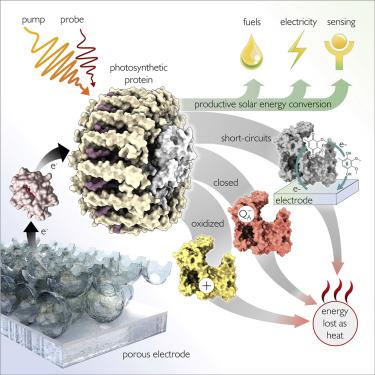Joule ( IF 39.8 ) Pub Date : 2023-03-15 , DOI: 10.1016/j.joule.2023.02.015 Wojciech J. Nawrocki , Michael R. Jones , Raoul N. Frese , Roberta Croce , Vincent M. Friebe

|
Photosynthetic reaction centers catalyze the majority of solar energy conversion on the Earth. Under low-intensity illumination, this is achieved with a near-unity quantum efficiency, almost every absorbed photon producing a photochemical charge separation. Biohybrid technologies seek to capture the high efficiency of natural photoproteins by combining them with man-made electrodes. However, the transfer of photoproteins from their membrane environment into an abiotic architecture invariably results in efficiency losses. Here, we combined spectroscopy and analytical electrochemistry to identify the loss processes in a reaction-center-based biophotoelectrode. While over 90% efficient under low-intensity illumination, the biophotoelectrode efficiency dropped to ∼11% under high-intensity illumination. This loss stemmed from bottlenecks in electron transfer that rendered 60% of reaction centers inactive, as well as a short-circuiting of 73% of the separated charge from active reaction centers. The quantitative insights into loss processes presented in this work will be instrumental in shaping future rational design of biophotoelectrode devices.
中文翻译:

原位时间分辨光谱电化学揭示了生物混合光电极性能的局限性
光合作用反应中心催化地球上大部分的太阳能转换。在低强度照明下,这是通过接近单位的量子效率实现的,几乎每个吸收的光子都会产生光化学电荷分离。生物混合技术试图通过将天然发光蛋白与人造电极结合来捕捉它们的高效性。然而,发光蛋白从其膜环境转移到非生物结构中总是会导致效率损失。在这里,我们结合光谱学和分析电化学来识别基于反应中心的生物光电极中的损失过程。虽然在低强度照明下效率超过 90%,但在高强度照明下生物光电极效率降至 ~11%。这种损失源于电子转移的瓶颈,导致 60% 的反应中心不活跃,以及 73% 的活性反应中心分离电荷短路。在这项工作中提出的对损失过程的定量见解将有助于塑造未来生物光电极设备的合理设计。


























 京公网安备 11010802027423号
京公网安备 11010802027423号